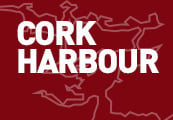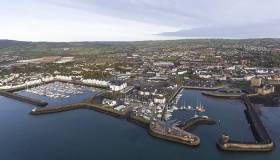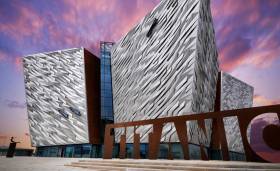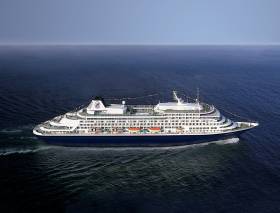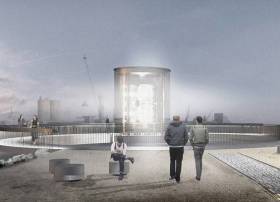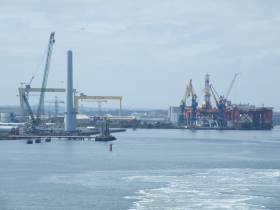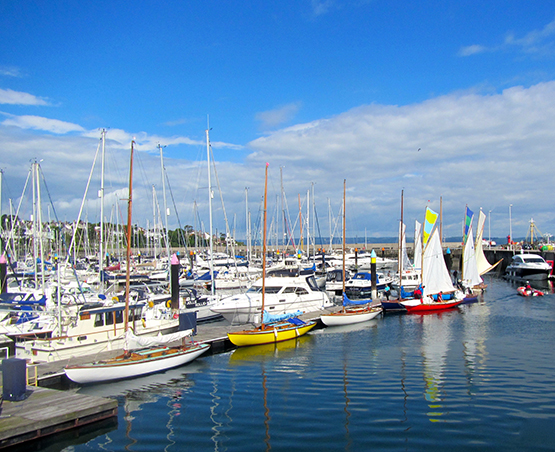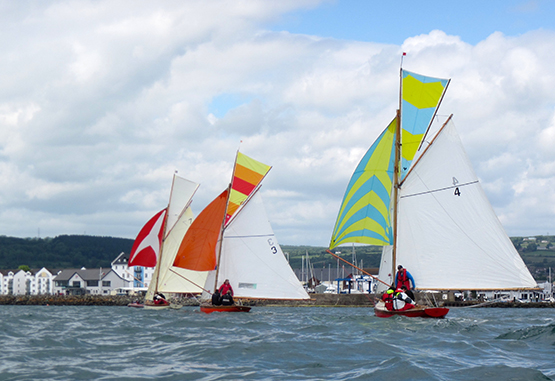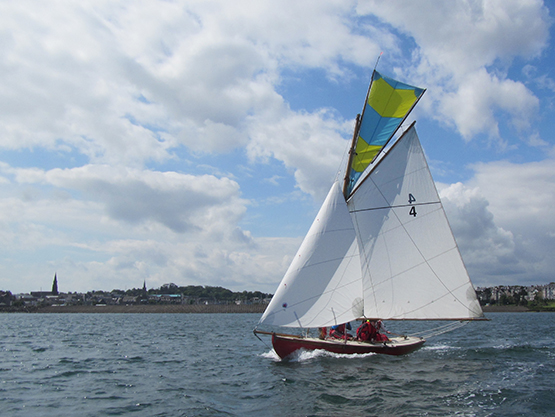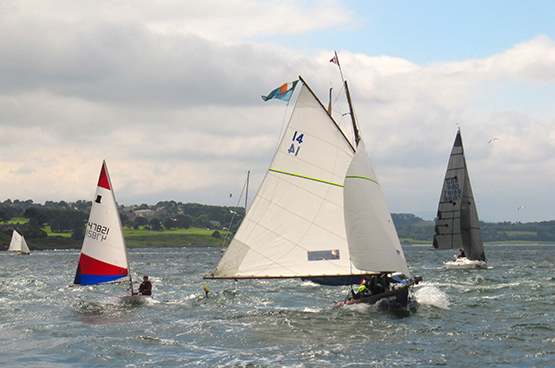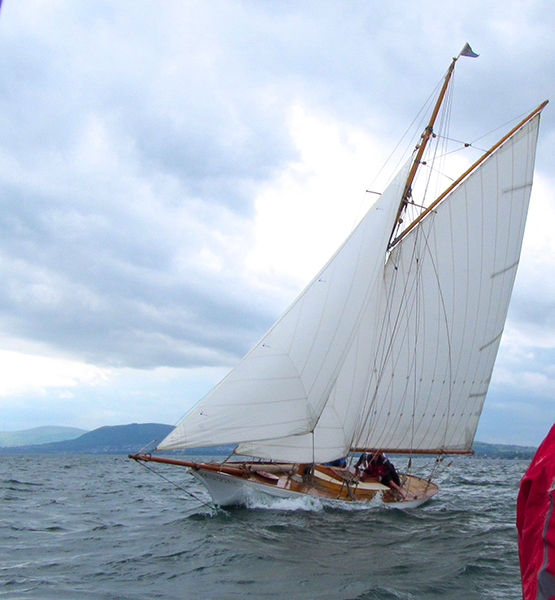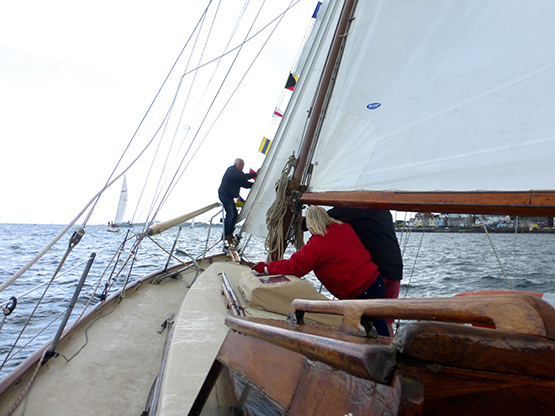Displaying items by tag: Belfast Lough
Carrickfergus Marina Makes the Perfect Base to Explore
Sponsored content: Carrickfergus Marina situated on the northern shore of Belfast Lough is making the most of the current Euro-Sterling exchange rates to highlight its Five Gold Anchor facility, with 300 fully serviced berths, to sailors and boat owners considering a change of berth on the East Coast.
The County Antrim marina has a choice of flexible contracts, and new customers taking out their first contract will get their first month free on a complimentary basis. In particular, its Winter Berthing Contract is £112.20 per metre for the six month period from 1 October 2016 till 31 March 2017.
Those coming in from 1 November onwards will be given pro-rata of this price, and again each new customer will receive the same discount.
Facilities at Carrickfergus
Customers at Carrickfergus Marina can avail of a boat yard on site, with a 40-ton travel hoist, chandlery and guardianage services are also provided. There is also an onsite brokerage service, and the long-established sailing club, with an active racing and cruising section. Club racing at Carrickfergus runs from Easter through to mid-December.
Twenty-four-hour security should give you peace of mind, while the marina also provides a dedicated berth for contract holders, a post-holding service for those on the go, and free Wi-Fi to stay connected. An extensive site refurbishment is currently underway to revamp the marina’s electrics and access systems, and a new family bathroom with separate shower is due to open in late winter.

Travelling to Carrickfergus
By car: Carrickfergus Marina is just over two hours from Dublin via the M1 and A1 to Belfast, then the M5 and A2 north along Belfast Lough. Car parking is available adjacent to the east and west gates into the marina basin.
By bus/train: The marina can be reached from Dublin in around three hours, by coach from Dublin to Belfast city centre and then local services to the main road outside the marina office, or by rail from Dublin Connolly to Belfast Central and local train (approx 25 minutes) to Carrickfergus station, a three-minute walk from the marina.
Carrickfergus as a destination
Spend a weekend, or a week, in Carrickfergus exploring the town’s unique local heritage, including its Norman castle and renowned St Nicholas’ Church, both dating from the 12th century, as well as the local heritage museum and Flame Gasworks Museum – Ireland’s sole surviving coal gasworks, one of only three left in the British Isles.
Go for a swim or a workout in the state-of-the-art gym at the Amphitheatre Leisure Centre; browse the selection of boutique shops in the town centre; and enjoy a meal in one of the many fine local restaurants — all located within a five-minute walk of the marina.
To keep the family entertained, the Omniplex multiscreen cinema across the road which also offers reduced-price child-friendly and ASD-friendly showings during holidays and weekends, and there is a brand new soft-play centre two minutes’ drive away.
No spare cabin for friends or family? They can stay at one of the town’s comfortable local hotels. Premier Inn is right across the road, while Dobbins Inn is a five-minute walk on the town’s main street, and the four-star Loughshore Hotel is a two-minute drive from the marina.
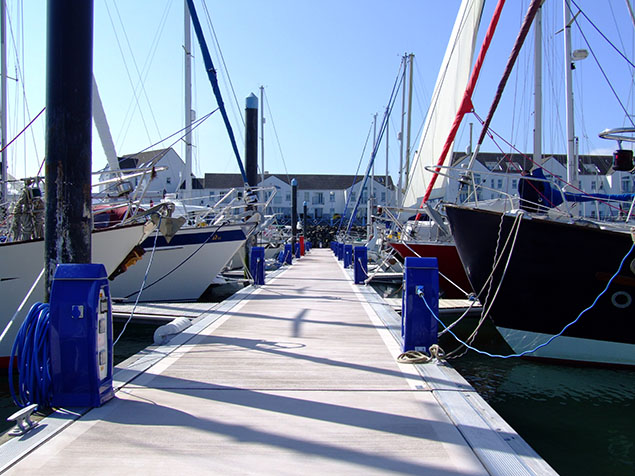
Contact details are as follows:
Carrickfergus Marina, Mid & East Antrim Borough Council, 3 Quayside, Carrickfergus, BT38 8BJ Telephone: 028 9336 6666
Website: www.midandeastantrim.gov.uk
Titanic Quarter Company Warns of Brexit Impact
#TitanicBrexit - Belfast’s Titanic Quarter, which is home to Northern Ireland’s and Europe's most popular tourist attraction, has reported losses for last year of £333,111 (€383,329), newly filed accounts show.
Titanic Island Limited, which controls the group of companies working in the quarter, said pretax losses narrowed from £1.16 million in 2014. The group previously reported a £68,000 loss for 2014, down from £33.9 million in 2013. It said the previous year’s results had been restated due to a transition to the FRS 102 reporting standard.
Turnover totalled £10.9 million for 2015 with operating profit rising from £1.96 million to £2.49 million.
For more on the potential of the Brexit impact to one of the world’s largest urban-waterfront regeneration projects, the Irish Times has a report by clicking here.
Top Travel Industry Award For Titanic Belfast
#TitanicBelfast - Titanic Belfast is Europe's leading tourist attraction, after scooping a top gong at a major industry awards ceremony.
Paying tribute to the ill-fated ocean liner RMS Titanic and its history in the city, the Belfast Lough visitor centre took the award for Europe's Leading Visitor Attraction at the World Travel Awards in Sardinia last night (Monday 5 September), according to TheJournal.ie.
The Guinness Storehouse, Buckingham Palace and the Colosseum in Rome were among the renowned tourist hotspots beaten to the prize, the first for Northern Ireland in the history of the awards.
As previously reported on Afloat.ie, the four-year-old venue saw a 2% growth in visitor numbers in the 12 months before March this year, along with a 7% growth in revenues.
HAL Visits Belfast On Celtic & Bourgundian Explorer Cruise
#HALcall – Holland America Line’s Prinsendam berthed in Belfast Harbour this morning as part of a 28 Day Celtic & Bourgundian Explorer Cruise, writes Jehan Ashmore.
This was the second call of HAL's Prinsendam to Belfast this season as she called in July. Overall, this morning's call was her 14th visit to the port having berthed at the Stormont cruise wharf. She has a capacity for more than 766 passengers and 460 crew.
Prinsendam at under 40,000 gross tonnage is the smallest of the HAL fleet which now has a newcomer, Koningdam, just shy of 100,000 gross tonnage. She was named in May as the first of the 'Pinnacle' class, the largest ever built for the US based operator, part of the Carnival Corporation. The newbuild can take a maximum of 3,200 passengers and over 1,000 crew.
Today’s call of Prinsendam represents the 29 caller and last of this month alone to Belfast. Asides, HAL, among the cruise operators they include Princess, Celebrity, Cunard, Silversea, Majestic, and Fred Olsen.
The port is to host almost 145,000 cruise visitors this season as the harbour is the principle gateway to the attractions of city and Northern Ireland.
Prinsendam had set off from Dublin, where she overnighted at Ocean Pier, within Alexandra Basin, where another fleetmate, Rotterdam had called earlier this month.
Large Heavylift at H&W for Repairs Following Wind Farm Project
#HeavyLiftVessel - Dutch marine speciliat, Van Oord's heavy lift-vessel, HLV Svanen arrived recently to Belfast Harbour, following installing the final wind turbine foundation at the Burbo Bank Extension wind farm in Liverpool Bay.
The 1990 built heavy lift installation vessel is moored at Harland and Wolff's Commissioning Quay. The sheerleg catamaran craft is to undergo repairs and outfitting at the marine engineering facility and shipyard, ahead of its next contract.
The HLV is taller than H&W's gantry crane Samson, which stands at 106m from the rails. Svanen has an impressive maximum lift capacity of 8,700 tonnes (excluding rigging; 8,200 tonnes including rigging).
To put this into perspective, the metal structure of the Eiffel Tower weighs 7,300 tonnes!
#MostPowerful - The world’s most powerful wind turbine blades continue to ‘breeze’ into Belfast Harbour, as part of a project to develop the Burbo 2 offshore wind farm on the Irish Sea as previously reported on Afloat. The blades – plus their 88m high towers are visible from across much of the city.
The first six massive 80m long blades – the equivalent length of nine double decker London buses – have arrived in Belfast Harbour’s offshore wind terminal from the Isle of Wight. The completed wind farm will provide enough renewable electricity for 230,000 homes.
Each blade weighs 35 tonnes and the turbines, which will be assembled in Belfast Harbour, will ‘sweep’ an area larger than the London Eye (21,124 sq m). During this phase of the project, 32 turbines will be assembled in Belfast. The blades are manufactured in the UK by MHI Vestas Offshore Wind.
After the turbines are assembled in Belfast they will be transported on a state-of-the-art jack up vessel which will install them on the seabed, just off the coast of Liverpool. The wind farm will cover 40km2, the same area of almost 6,000 Premiership football pitches.
Once operational, the tip height of the blade and turbine will be almost 200m. The record level of energy produced from just one turbine in a 24-hr period is 192 MWh – the same amount of energy produced by 22,600 litres of oil.
The blades, which were designed, tested and manufactured at the MHI Vestas on the Isle of Wight, will be the first UK built blades to be installed at a British offshore wind power plant.
#MewIslandOptic - A rare lighthouse lens that helped guide ships into Belfast Lough for more than a century is to get a new home on the city's waterfront, as the Belfast Telegraph reports.
The optic from Mew Island Lighthouse, one of Ireland's tallest lights, will be housed in a much more accessible structure designed by architects Hall McKnight.
The firm fended off 11 other tenders to win the commission by the Titanic Foundation for the new monument to Northern Ireland's seafaring traditions, one that's intended to last for at least another 100 years.
With a design echoing a lighthouse lantern room, the structure will house what's believed by many to be the largest Fresnel lens, produced in Paris by master glassmakers in 1887.
The Belfast Telegraph has more on the story HERE.
Burbo 2 Wind-Farm Blades Arrive in Belfast Harbour
#WindFarm - Blades for a wind-farm in the Irish Sea have begun to arrive in Belfast Harbour reports ReNews.
The blades are for the MHI Vestas V164 8MW turbines destined for Dong Energy’s 256MW Burbo 2 offshore wind-farm in the Irish Sea.
The 80-metre blades for the 32 machines have been manufactured at MHI Vestas's factory on the Isle of Wight.
The turbines will be loaded out in September by A2Sea.
Bladt Industries and EEW are responsible for the project’s foundations, which are currently being installed by Dutch company Van Oord.
#Turnover2015 - Harland and Wolff Group (H&W) writes the Belfast Telegraph continues to operate in testing market conditions as a diverse engineering business.
The company, a subsidiary of the Fred Olsen Energy Group, operates in shipbuilding, heavy engineering, ship repair, and floating production and drilling vessels for off-shore oil and gas industry.
Despite difficult trading, annual turnover increased in 2015 to over £66m, the highest level of the past decade. The higher turnover came in a period of much tighter trading profit margins although the end year results did show a smaller operating profit.
During the recent year the company provided services to 21 different vessels (27 in 2014). There was useful business from the continuing relationship with the Irish Sea ferry operators, Stena Line.
To read more click here
Afloat.ie’s W M Nixon grabbed only a few hours sleep after his almost continuous coverage of the Volvo Round Ireland Race 2016 before haring off to Bangor in County Down to sail in the RUYC 150th Anniversary Regatta on Saturday June 25th aboard the same boat on which he took part in the same club’s Centenary Regatta in 1966 – and with the same crew. But he arrived at his former home port to find that the defining sailing symbols of his more recent home port of Howth had got there before him…
The amateur yacht designer Walter Boyd of Howth crewed on his father’s 72ft cutter Thalia in the Royal Ulster Yacht Club regatta at Bangor on Belfast Lough in July 1897. A week earlier, the Boyd family had concluded their accumulation of tidy sums in prize money in the Clyde Fortnight with the 1891-vintage Fife-designed Thalia. Ironically, Thalia had been sold away from the Clyde to Judge Boyd of Howth in 1892 at a bargain price, as her original Scottish owners felt she was being out-classed by the new boats from the other Scottish designer, G L Watson. But the Boyd family seemed well able to demonstrate otherwise.
Certainly by 1897 it was Fife who was again in vogue with newer winners like Isolde and Ailsa, and that year saw the advent of the new Fife-designed Belfast Lough One Design Association 25ft LWL Class I boats, built by up-and-coming boatbuilder John Hilditch of Carrickfergus on the north shore of Belfast Lough.
They made a very favourable impression on their debut at Clyde Fortnight in late June and early July 1897 closely observed by, among many others, the Boyd family on Thalia. And after returning to strut their stuff at home at the Royal Ulster regatta in mid-July, four of the BLOD 25s then went on to race for several days in the Dublin Bay regattas, making such a good showing that it inspired the formation of the Dublin Bay 25ft OD Class.
The Dublin boats, with the first appearing in 1898, were of the same hull profile, but with slightly finer sections and built to a much higher specification, with a lead ballast keel as opposed to the Belfast Lough boat’s cheap-and-cheerful cast iron.
Yet even while the pundits of the Clyde, Belfast Lough and Dublin Bay were debating the merits of one against the other, and indeed whether it was even a feasible idea to have a One Design of such a size that she was capable of going offshore, the Howth men returned to their peninsula home, and cogitated among themselves on what they had seen. They were looking for something economical to replace the deathtraps which were the Half Raters they’d been racing for three or four seasons.
Bangor Marina with some of the Mylne-designed Glens from Strangford Lough in the foreground, and jackyard topsails much in evidence on the Howth 17s beyond as they prepare to race across Belfast Lough to their 1898 birthplace of Carrickfergus. Photo: Trish Nixon
The result was that by the end of October 1897, Walter Boyd had produced a design for an able little 17ft LWL, 22.5ft LOA gaff sloop complete with jackyard topsail. An order to build the first five was immediately placed with John Hilditch at Carrickfergus. And by the beginning of April 1898, these new Howth 17s were ready to be sailed the 90 miles to their home port by their notably keen owners. From design finalisation to first race took barely six months, which tells us much about the spirit of the 1890s.
The world has moved on since 1898, but there is still a numerous class of Howth 17s at Howth, including the original five built by John Hilditch at Carrickfergus. In 1998 a flotilla of them returned by road to their birthplace for some decidedly crisp Easter sailing to celebrate their Centenary, and then – the wind being fair – they all made a fast if freezing overnight sailing passage home.
The Return of the Seventeens – approaching Carrickfergus SC on June 23rd 2016, Ian Malcolm’s Hilditch-built Aura (7) leads from Roddy Cooper’s Leila (3, also Hilditch-built) while third lies Class Captain Tom Houlihan in the 1899-built Zaida. Photo: Trish Nixon
Since then, they’ve had further outings to various classic events, with a couple even managing Brest on one occasion, and the Solent Classics on another. But their most impressive outing was in 2003 when no less than 15 boats were moved in a masterclass of logistics to the Glandore Classics. So although the regular annual race programme, which provides them with sixty races each summer at Howth, is the backbone of the class, now and again other possibilities turn up, and for 2016 there was a double offering on Belfast Lough.
There, sailing seems to have suddenly taken off in 1866, as 2016 offered both the 150th Anniversary of Carrickfergus Sailing Club with a special Hilditch Regatta to celebrate the memory of a boatbuilder who was in business for only 24 years from 1889 to 1913, but he was very productive during those years. And it was also the 150th Anniversary – the Sesquicentennial, forsooth – of the Royal Ulster Yacht Club, which had started life as the Ulster Yacht Club in 1866, but thanks to having Lord Dufferin of high latitudes cruising fame as Commodore, by 1869 they’d the Royal warrant.
Yet when the Howth 17s’ designer raced with his father and siblings aboard the Thalia at Bangor in 1897, the RUYC was still modestly housed in a rented semi-detached house – a big semi-detached house admittedly – above the Bangor seafront. So although the Belfast Lough season of 1898 had still not begun when the new Howth 17s sailed past homeward bound in April 1898, there was a flurry of building work under way on the Bangor waterfront, as RUYC had acquired an important new member, and he required the club to have a proper clubhouse to provide a base for a project he had in mind.
First time together – the RNIYC Fairy Class, built by John Hilditch in 1902, get together in Carrickfergus with the Howth 17s (built Hilditch 1898) Photo: Trish Nixon
The new member was Thomas Lipton, already a multi-millionaire with a rapidly expanding grocery empire. His ambition was to challenge for the America’s Cup, and his notions of grandeur chimed well with the feelings of a significant group of the RUYC membership, who felt that a rented semi-detached house, despite its desirable seafront location, was no longer adequate for their rapidly rising status in the world of yachting.
A mid-season meeting of RUYC members in 1897 had already decided that a new clubhouse be built, and architect Vincent Craig – a keen sailing man – soon produced an Arts & Crafts-inspired design with a hint of the Scottish baronial for the selected dominant site. The whole extraordinary confection of a building, with a sort of inspired “instant antiquity” in the mood it created, was built in 18 months, with the opening in April 1899. As we were suggesting earlier, things got done – and done quickly – in Belfast Lough in the 1890s.
The 1899-completed clubhouse of the RUYC was built in a near-record time of 18 months. Photo: W M Nixon
Since then, Thomas Lipton’s five America’s Cup challenges have come and gone, and though he never won, he was definitely a serious contender in 1901 and 1914. World wars have since been fought, empires have disappeared, the global map has changed, and the world structures of sailing have been re-configured. Yet the Royal Ulster YC’s history-laden clubhouse continues to brood above the Bangor waterfront. And the Howth 17s remain unchanged at Howth. They and the RUYC clubhouse are almost exactly the same age. Clearly, the Sesquicentennial Regatta offered a very special opportunity for these two relics of old decency to get together for the very first time.
Of course, there was far more to the events of this past week and more on Belfast Lough than this. But when a 118-year-old class is kept in good order in one place, and a 117-year-old clubhouse of real character is lovingly maintained in another, there’s every possibility of an interesting chemical reaction when the two get together.
But for me, interest in this event was in another direction entirely, for 1966 was the last year in which most of my sailing was Belfast Lough-based. I tended to head south thereafter, soon re-locating in Howth. But for the Centenary Year of 1966, it was Belfast Lough and RUYC virtually all the way, and as on many occasions during the 1960s, there was a June cruise with the chartered 9-ton yawl Ainmara – designed and built by John Kearney of Ringsend in Dublin in 1912 – to West Cork.
It was the first proper sailing visit to West Cork, for though we’d called at Baltimore while coming in from the west coast during an anti-clockwise round Ireland cruise with Ainmara in 1964, for 1966 we lingered on in summer somnolence (remember when summers had somnolence?) in sweet places like Glandore and Castlehaven when they were decidedly less crowded than they are today.
The only time limit on this easy-going venture was to get Ainmara back to Belfast Lough in time for the Centenary Regatta of the RUYC at the end of June 1966, for the old girl (we already thought of her as very old in 1966) had recently passed into the ownership of Dickie Gomes, and as an RUYC member and very proud of his newly-acquired boat, this was definitely a must-do fixture.
The day itself was one of a sunny though not overstrong nor’easterly, but as it would have set up an awkward little popple in the Belfast Lough sea state, Ainmara was not at her best against more modern boats in the windward work. So although there’s a medallion on the bulkhead in Ainmara’s saloon to commemorate her participation in this Centenary Regatta, fifty years later neither Dickie Gomes nor his wife Deirdre nor I – all of us on board at the time – have any idea of our result, but we’re reasonably sure it wasn’t a win, so blessed amnesia has been at work in the intervening fifty years.
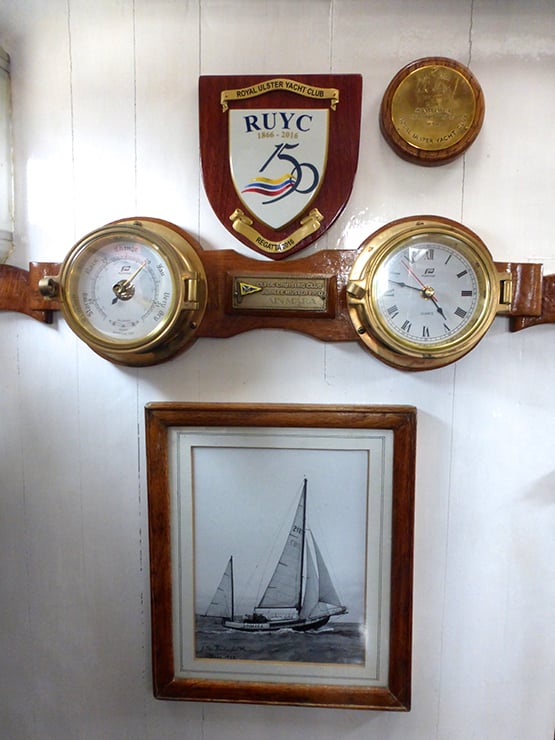
The saloon bulkhead in Ainmara now has the addition of the 150th Anniversary plaque. The medallion top right commemorates the RUYC Centenary Regatta of 1966, between the clock and the barometer is a smaller plaque commemorating participation in the Clyde Cruising Club’s Golden Jubilee Cruise-in-Company in 1969, and the photo is of Ainmara at the start of the CCC’s 1972 race from Inverness across the North Sea to Norway. Photo: W M Nixon
During those same fifty years, while Dickie kept on with Ainmara and did many things with her, including racing to Norway and cruising to the Outer Hebrides and southern Brittany and notching success in many North Channel offshore races, he also spread his wings in many other sailing directions. In 1982 he and sailing friend Brian Law built the 40ft Dick Newick trimaran Downtown Flyer with which they scored a raft of successes in events up to the international Round Britain and Ireland level, and in 1986 – in November, no less - he established a new Round Ireland Record with the 83ft catamaran Novanet. This record stood until Steve Fossett came along to snatch it with the trimaran Lakota in September 1993, and then in 1988 Dickie Gomes found himself back in mono-hulls, in command of Brian Buchanan’s Frers 49 Hesperia (she’s now Jamie Young’s Killary Flyer down in north Connemara), and was overall winner of the 1988 Round Ireland Race.
This successful relationship with Hesperia became a feature of the sailing scene for many years, and during this period Ainmara was resting in a shed at Dickie and Deirdre’s farm in the Ards Peninsula in east County Down, awaiting repairs and refurbishment after breaking from her moorings in Strangford Lough in a winter storm. But she’s a tough old bird, John Kearney built her well, she was well worth restoring, and there was never any doubt that, whatever the other distractions, she’d be sailing again for her own Centenary in 2012.
She was out and about again in 2011, her Centenary in 2012 was then marked with a celebratory cruise to the Outer Hebrides, and in 2013 she played a starring role in the Golden Jubilee Celebrations of the Old Gaffers Association, adorned with prizes too, for although Ainmara has been Bermudan-rigged since the 1930s, she’s revered as an honorary gaffer.
Tom Houlihan’s Howth 17 Zaida off Bangor. Photo: Trish Nixon
The Sesquicentennial Parade of sail was a real floating come-all-ye, with Toppers and other dinghies mixing it with Howth 17s such as the award-wining Gladys (14) and modern cruiser-racers. Photo: Betty Armstrong
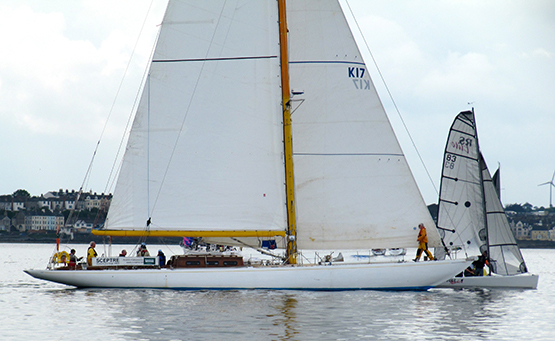
History afloat. The 1958 America’s Cup Challenger Sceptre off Bangor with an RS Elite. There’s more to this than meets the eye – the RS Elite is Phil Morrison’s miniaturized take on the special America’s Cup Class which succeeded the 12 Metres such as Sceptre as the boat of choice in AC racing. Photo: Betty Armstrong
Thus the up-coming RUYC Sesquicentennial Regatta was seen as a celebration of many things, of friendships which have withstood the test of time for many decades, of wonderful old boats which continue to give great sport, and of a surreal clubhouse which had become increasingly irrelevant as sailing’s focus shifted to smaller boats with amateur crews, but then found a new role as a sort of living museum of sailing history when Bangor was provided with what was then Ireland’s largest marina in 1991. This elevated the old clubhouse on the hill into a sort of Temple of Sailing, where devotees of the more rugged versions of the sport can retreat to reflect on their experiences in a peaceful setting well away from the hurly-burly of the marina waterfront.
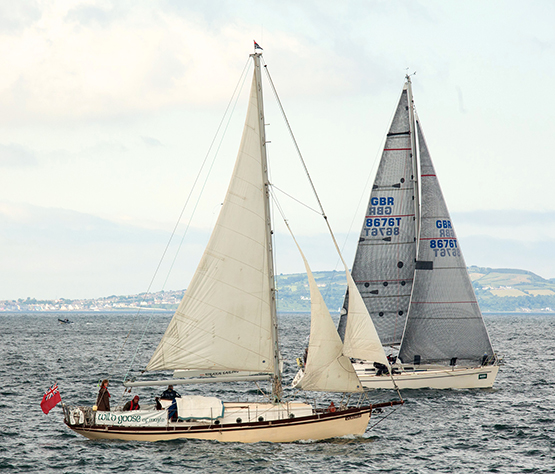
The RUYC Sesquicentennial attracted boats from every background. This is Wild Goose from Portrush, renowned in times past for her links with sailing writer Wallace Clark. She has been complete up-graded in a somewhat changed form by Robin Ruddock of Portrush, who brought her to Bangor to salute 150 years of Belfast Lough sailing. Photo: Andrew Gallagher
So how do you celebrate the 150th Anniversary of such a remarkable institution? It’s of special interest in Ireland, as we are already anticipating the 300th Anniversary of the Royal Cork Yacht Club in 2020. In Bangor, RUYC Vice Commodore Myles Lindsay and Rear Commodore Greg Taylor and their team put together an intensive four week programme which has seen a variety of events including the Sigma 33 Championship, a Classic Yacht Regatta, a 150th Anniversary Regatta which included a wide range of boats reflecting Belfast Lough and Ireland’s sailing’s diversity, while this weekend it is concluding with an assembly of the Cruising Clubs which will mercifully see the focus of activity move gracefully up the west coast of Scotland and into the Hebrides in a Cruise-in-Company which will enable them to pause for breath back in Bangor.
In tandem with this, the Hilditch Regatta at Carrickfergus drew in the Bangor-assembled boats on Thursday June 23rd for a good day of sailing, and for the first time ever it brought the Hilditch-built Howth Seventeens which had breezed in from Bangor together with the Hilditch-built (1902) Fairy Class from the Royal North of Ireland YC across the lough, plus sundry other craft including the Ainmara, without which no proper boat event in the north is complete.
Hal Sisk’s 1894-built Peggy Bawn returns to her birthplace of Carrickfergus in June 2016. Photo: Trish Nixon
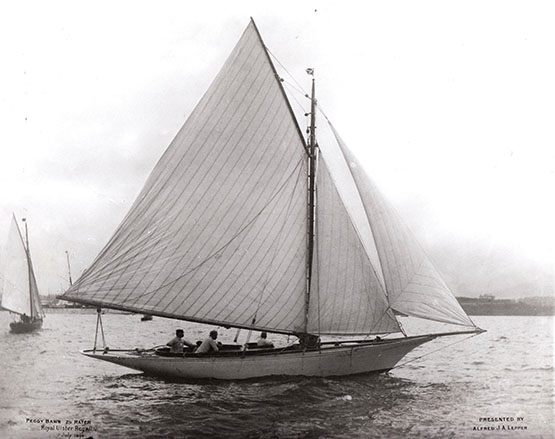
Peggy Bawn on Belfast Lough in 1894. Photo courtesy RUYC
However, by any standards the star of the show was Hal Sisk’s meticulously-restored G L Watson-designed 36ft Dun Laoghaire-based Peggy Bawn, a Hilditch-built cutter of 1894 vintage. While the Howth 17s are still as originally designed, although standards are rising every year they’re not all yet to classic yacht standards. As for the Fairy Class, they have been changed to Bermudan rig. And the old Ainmara and others like her are clearly not as originally designed. But Peggy Bawn is in a league of her own - she’s so authentic and exquisitely finished that it hurts.

Roddy Cooper’s Leila (built 1898) and the RUYC clubhouse (built 1899) get together for the first time. Photo: Betty Armstrong
The Howth Seventeens re-assembled back in Bangor to find they were seven in all, a gathering made easier - when you’ve only four road trailers - by the fact that the father of the class, Nick Massey, crewed by Dave Nixon, had sailed the 1907-built Deilginis from Howth to Bangor in two swift daylight stages, with a stop in Ardglass. They were now joined by six boats of the Glen Class which had sailed round from Strangford Lough, for although the Alfred Mylne-designed 25ft Glens – which originated in 1947 – are now found only in Strangford Lough and Dun Laoghaire, they began life as an RUYC Class, built in Bangor at the long-extinct Glen Boatyard on Smeltmill Bay to the west of the town.
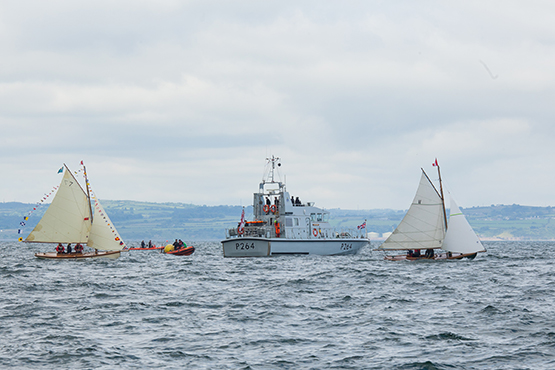
Howth 17 overall winner Aura (Ian Malcolm, left) and Deiliginis, which sailed from Howth to Bangor, parade past the guardship HMS Archer. Photo: Andrew Gallagher
Together with the restored local 18ft keelboats of the 1902 Waverley class in Bangor, there was now a comprehensive gathering of past and present to sail forth in the RUYC Sesquicentennial last Saturday. Your reporter arrived on board Ainmara in reasonable time to find the doughty skipper and his shipmate Brian Law dressing the old boat overall, while just across the pontoon was the 1958 America’s Cup Challenger, the 12 Metre Sceptre, on one of her regular outings from the north of England. And across the way was Dutch skipper Ben Korner’s Open 40 Masai, recently retired from the Volvo Round Ireland Race thanks to a broken forestay fitting, hugely frustrating as they’d been in a splendid battle through the North Channel against RORC Commodore Michael Boyd’s First 44.7 Lisa, which went on to place third overall.
At this stage of the day there still seemed a chance of some lasting sunlight, but as Ireland was plumb under the malign influence jetstream, weatherwise it was a day of everything except what you wanted. But in terms of a reunion it was perfect, as I sailed again with Dickie and Deirdre Gomes, and our crew was joined by Jervis “Jess” Fleming home in holiday from West Australia – last time we sailed together, it was on that early June cruise of 1966 in Ainmara to West Cork.
With winds fluking around between northwest and northeast and sudden gusts coming from everywhere, the water of Belfast Lough were in a horrible popple which was a death knell for Ainmara’s afternoon racing hopes, but first there was the main part of the programme, the Sesquicentennial Parade of Sail, and for that the breeze was in brisk form.
Doughty skipper Dickie Gomes (age undisclosed) takes to the bowsprit to clear Ainmara’s jib topsail, while Deirdre Gomes (back to camera) and Jervis Fleming, both of whom sailed on the boat in 1966, get ready to tail on the halyard. Photo: W M Nixon
In fact, if it hadn’t been a Parade, we wouldn’t have dreamt of sending up our jib topsail. But our doughty skipper – whose chronological age is a secret, he’s permanently 25 in apparent terms – was soon out on the bowsprit clearing it for hoisting, the motley crew got it aloft, and in the nick of time the old girl was roaring along at full chat to cross the line in top style – even her bunting looked its very best.
As for the racing, we had our moments, but were stopped still for too long, while newer boats glided ahead, to figure in any prize-worthy placings. But frustration was soon allayed by a fresh new nor’wester which we enjoyed so much we sailed an entirely superfluous circuit of the course, and then back in the berth the old saloon was so comfortable and filled with memories that we yarned well past the time when we should have been up in the club for the official events. But we touched base there in time for our skipper to get his prize as Best in Show, which was all due to that last-minute full blossoming of the jib topsail just as the old girl came roaring up to the parade area inside the Royal Navy’s HMS Archer.
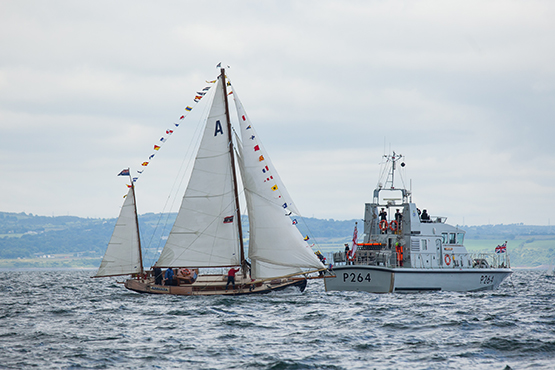
Made it in the nick of time……Everything up and drawing as Ainmara sweeps past the Guardship. Photo: Andrew Gallagher
The Howth 17 crews were made welcome and made themselves very much at home in the RUYC clubhouse. Photo: W M Nixon
So fifty years after the Centenary Regatta, Ainmara’s participation in the RUYC Sesquicentennial Regatta had hit the jackpot. The high was maintained all evening amidst much banter from the Howth 17 crowd, who had made themselves thoroughly at home in RUYC, with Ian Malcolm’s Hilditch-built Aura reckoned the best performer, though the 1907-built Gladys (Pat Heydon, Ian Byrne and Eddy Ferris) got the award for best-dressed overall. As Ian Byrne revealed, they’d gone to the trouble of putting their signal flags in the approved naval order, and these things count when you’re celebrating a 150th birthday.
The One-Designs had another day’s racing on the Sunday, but our job was done, and we’d to get Ainmara home to her secret place among the islands of Strangford Lough. As all the Howth 17s were going to be road-trailed home, Paddy Cronin with the 36ft Westerly Conway Aquarius of Howth was no longer needed as mother-ship, so we were his pilot veseel in an effortless if damp passage down the County Down coast, through Strangford Narows with the surging flood tide, and on along a winding route to Ballydorn, where the snuggest of berths was shared at the pontoon at Down Cruising Club’s lightship headquarters. It was a good end to some very special days.
The weekend comes to a close in a very special place. Ainmara with Aquarius of Howth berthed alongside the Down Cruising Club’s pontoon at its lightship headquarters at Ballydorn in Strangford Lough. Photo: W M Nixon


